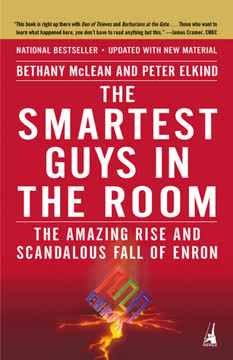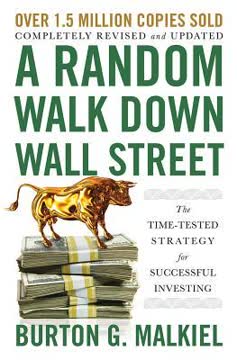Key Takeaways
1. High-frequency trading exploits structural inefficiencies in the stock market
"The financial markets were designed to maximize the number of collisions between ordinary investors and high-frequency traders—at the expense of ordinary investors, and for the benefit of high-frequency traders, exchanges, Wall Street banks, and online brokerage firms."
Market exploitation: High-frequency trading (HFT) firms leverage advanced technology and complex algorithms to exploit tiny price discrepancies and structural inefficiencies in the stock market. These firms:
- Execute trades in microseconds, faster than human traders can react
- Utilize sophisticated order types to gain advantages over other market participants
- Employ strategies like "electronic front-running" to profit from other investors' trades
Impact on investors: This practice negatively affects ordinary investors by:
- Increasing market volatility and instability
- Driving up transaction costs for long-term investors
- Eroding trust in the fairness and integrity of financial markets
2. The U.S. stock market became increasingly complex and opaque
"The U.S. stock market now traded inside black boxes, in heavily guarded buildings in New Jersey and Chicago. What goes on inside those black boxes is hard to say—the ticker tape that runs across the bottom of cable TV screens captures only the tiniest fraction of what occurs in the stock markets."
Market fragmentation: The U.S. stock market evolved from a centralized system to a fragmented network of exchanges and dark pools:
- Over a dozen public exchanges and numerous private trading venues
- Complex order types and pricing models that are difficult for most investors to understand
- Lack of transparency in how trades are executed and routed
Technological complexity: The market's infrastructure became increasingly sophisticated:
- High-speed data connections between exchanges
- Co-location services allowing traders to place their servers near exchange matching engines
- Advanced algorithms driving trading decisions in milliseconds
This complexity made it challenging for regulators, investors, and even many market participants to fully comprehend how the market truly functions.
3. Brad Katsuyama uncovers predatory practices in electronic trading
"Brad Katsuyama's most distinctive trait—his desire to explain things not so he would be understood but so that others would understand—was so seditious. He attacked the newly automated financial system at its core: the money it made from its incomprehensibility."
Uncovering the problem: Brad Katsuyama, a trader at Royal Bank of Canada, discovered that his trades were being front-run by high-frequency traders. He realized:
- His orders were reaching different exchanges at slightly different times
- HFT firms were using this speed advantage to trade ahead of his orders
- The market displayed on his trading screen was not the real market
Seeking solutions: Katsuyama's journey to understand and address this issue led him to:
- Develop "Thor," a trading tool that synchronized order arrival at different exchanges
- Educate investors and market participants about the unfair practices in electronic trading
- Eventually create IEX, a new stock exchange designed to level the playing field
4. Technological arms race creates unfair advantages for certain traders
"There was nothing new about the behavior they were at war with: The U.S. financial markets had always been either corrupt or about to be corrupted."
Speed advantage: The race for faster trading speeds created an uneven playing field:
- Firms invested millions in high-speed data connections and co-location services
- Microsecond advantages became valuable in executing trades
- "Latency arbitrage" emerged as a profitable strategy for HFT firms
Information asymmetry: Technological superiority led to informational advantages:
- HFT firms could see and react to market changes faster than other participants
- Complex order types allowed certain traders to gain insight into other market participants' intentions
- The "SIP" (Securities Information Processor) provided slower market data to most investors compared to the direct feeds used by HFT firms
5. Wall Street's dark pools enable exploitative trading practices
"To an astonishing degree, since the implementation of Reg NMS, the U.S. financial markets had evolved to serve the narrow interests of Scalpers Inc."
Dark pool proliferation: Major Wall Street banks created private trading venues called dark pools:
- Promised to protect investors from predatory HFT practices
- Lacked transparency in their operations and order execution
- Often prioritized their own trading interests or those of HFT firms
Conflicts of interest: Dark pools presented several ethical concerns:
- Banks could trade against their own clients' orders
- HFT firms were given preferential access to dark pools
- Investors' orders were often not routed to the venues offering the best prices
These practices undermined the fairness and efficiency of the market, often at the expense of ordinary investors.
6. IEX emerges as a potential solution to level the playing field
"IEX represented a choice. IEX also made a point: that this market which had become intentionally and overly complicated might be understood."
Fair exchange model: Brad Katsuyama and his team created IEX (Investors Exchange) with the goal of creating a more equitable trading environment:
- Implemented a 350-microsecond delay to neutralize speed advantages
- Offered simple, transparent order types
- Eliminated rebates and other incentives that could create conflicts of interest
Challenges to adoption: IEX faced resistance from established players:
- Major banks were reluctant to route orders to IEX
- Competing exchanges criticized IEX's model
- Regulatory hurdles in gaining exchange status
Despite these obstacles, IEX gained support from investors and some forward-thinking industry players, demonstrating the demand for a fairer market structure.
7. Ethical concerns arise as financial institutions prioritize profits over fairness
"The funny thing was that Serge actually liked Adam Schles-inger, and most of the other people he worked with at Goldman. He liked less the environment the firm created for them to work in. 'Everyone lived for the year-end number,' he said."
Profit-driven culture: The focus on short-term profits often overshadowed ethical considerations:
- Traders and executives prioritized personal bonuses over market integrity
- Banks developed complex financial products that were difficult for clients to understand
- Firms exploited regulatory loopholes to gain advantages
Lack of accountability: The complex market structure made it difficult to assign responsibility for unfair practices:
- Blame was often shifted to "technical glitches" or market complexity
- Regulators struggled to keep pace with rapid technological changes
- Whistleblowers faced significant career risks for exposing wrongdoing
8. Regulatory challenges in addressing high-frequency trading issues
"The SEC, like the public stock exchanges, had a kind of equity stake in the future revenues of high-frequency traders."
Regulatory lag: Government agencies struggled to keep up with rapidly evolving market technologies:
- Existing regulations, like Reg NMS, had unintended consequences that favored HFT firms
- Regulators lacked the technical expertise to fully understand new trading strategies
- The revolving door between regulators and industry created potential conflicts of interest
Enforcement difficulties: Proving and prosecuting market manipulation became increasingly challenging:
- Complex trading algorithms made it hard to demonstrate intent
- The sheer volume of market data overwhelmed regulatory systems
- Jurisdictional issues arose as trading became more global and fragmented
9. The power of individual action in reforming financial markets
"It wasn't high-frequency trading in itself that was pernicious; it was its predations. It wasn't necessary to eliminate high-frequency traders; all that was needed was to eliminate the unfair advantages they had, gained by speed and complexity."
Catalyst for change: Brad Katsuyama's journey demonstrates how individuals can drive meaningful reform:
- Identifying and exposing unfair practices in the market
- Educating investors and industry participants about complex issues
- Developing innovative solutions to address systemic problems
Building coalitions: Effective reform required collaboration across the industry:
- Gathering support from like-minded individuals within financial institutions
- Partnering with investors to create demand for fairer market structures
- Engaging with regulators and policymakers to drive regulatory changes
The story of IEX shows that even in a highly complex and entrenched system, dedicated individuals can make a significant impact by pursuing ethical solutions and building support for reform.
Last updated:
FAQ
What's Flash Boys by Michael Lewis about?
- High-Frequency Trading Focus: Flash Boys delves into the rise of high-frequency trading (HFT) in the U.S. stock market, highlighting its transformative impact on trading dynamics.
- Wall Street Dynamics: The book explores how technology and speed have created a new class of traders who profit from milliseconds, often disadvantaging ordinary investors.
- Personal Stories: Through characters like Brad Katsuyama and Ronan Ryan, it reveals the human element and ethical challenges in the technology-driven trading environment.
Why should I read Flash Boys by Michael Lewis?
- Insight into Financial Markets: The book provides a comprehensive understanding of modern financial markets and the role of technology in trading.
- Engaging Storytelling: Michael Lewis combines thorough research with a narrative style that reads like a thriller, making complex topics accessible and entertaining.
- Awareness of Market Inequities: It raises critical questions about fairness and transparency, encouraging readers to think about the implications of HFT.
What are the key takeaways of Flash Boys by Michael Lewis?
- Market Manipulation Exists: High-frequency traders manipulate the market to their advantage, often at the expense of regular investors.
- Need for Transparency: The book emphasizes the importance of transparency in financial markets and advocates for reforms to level the playing field.
- Human Element in Trading: It highlights the motivations and challenges faced by individuals striving for fairness in a corrupt system.
What are the best quotes from Flash Boys by Michael Lewis and what do they mean?
- "A man got to have a code.": This quote underscores the importance of ethics and integrity in a world where many exploit the system for personal gain.
- "The U.S. stock market now trades inside black boxes.": It reflects the opacity of modern trading practices and the need for greater transparency.
- "The average investor has no hope of knowing.": This statement highlights the disconnect between Wall Street and everyday investors, emphasizing the need for awareness and action.
What is high-frequency trading (HFT) as defined in Flash Boys by Michael Lewis?
- Definition of HFT: High-frequency trading involves using advanced algorithms to execute trades at extremely high speeds, often in milliseconds.
- Market Impact: HFT accounts for a significant portion of trades, raising concerns about market stability and fairness.
- Ethical Concerns: The book discusses how HFT can disadvantage regular investors, questioning the fairness of a system that allows a select few to profit from speed and access to information.
How does Flash Boys by Michael Lewis illustrate the concept of market manipulation?
- Front-Running Orders: High-frequency traders engage in front-running, buying stocks based on knowledge of pending orders from other investors.
- Use of Technology: Traders use algorithms to gain insights into market movements before they are visible to the public, creating an uneven playing field.
- Systemic Issues: The book points to systemic flaws that allow manipulation, calling for reforms to protect investors from predatory practices.
What role do characters like Brad Katsuyama and Ronan Ryan play in Flash Boys by Michael Lewis?
- Brad Katsuyama's Journey: Katsuyama is a principled trader seeking transparency and fairness, driving the narrative to expose market predation.
- Ronan Ryan's Expertise: Ryan provides technical knowledge to understand HFT complexities, shaping solutions proposed by Katsuyama.
- Collaboration for Change: Their partnership illustrates how ethical considerations and technical expertise can lead to meaningful reforms.
How does Flash Boys by Michael Lewis address the issue of transparency in financial markets?
- Call for Transparency: The book advocates for greater transparency, arguing that the current system favors high-frequency traders.
- Impact of Dark Pools: It discusses how dark pools operate without scrutiny, leading to potential exploitation of investors.
- Regulatory Recommendations: The narrative suggests regulatory changes to ensure transparency and protect investors.
What are the implications of the flash crash discussed in Flash Boys by Michael Lewis?
- Market Vulnerability: The flash crash highlights vulnerabilities in the financial system and the risks associated with high-frequency trading.
- Need for Regulation: It underscores the necessity for regulatory oversight to prevent similar occurrences in the future.
- Investor Confidence: The event eroded investor confidence, demonstrating the need for transparency and accountability.
How does Flash Boys by Michael Lewis depict the relationship between Wall Street banks and high-frequency traders?
- Mutual Dependence: Wall Street banks rely on high-frequency traders for liquidity, while HFT firms depend on banks to route orders.
- Conflicts of Interest: The book highlights conflicts when banks prioritize profits over client interests, raising ethical concerns.
- Systemic Risks: This relationship contributes to systemic risks, leading to market manipulation and increased volatility.
What solutions does Flash Boys by Michael Lewis propose to address the issues in financial markets?
- Creation of a New Exchange: The book proposes establishing a stock exchange prioritizing fairness and transparency to protect investors.
- Advocacy for Regulatory Reforms: It calls for changes enhancing transparency and accountability in financial markets.
- Empowerment of Investors: By raising awareness of HFT challenges, the book encourages a more informed and engaged investor base.
How does Flash Boys by Michael Lewis challenge conventional views of Wall Street?
- Critique of the System: The book exposes how Wall Street is rigged against ordinary investors, questioning the integrity of the financial system.
- Highlighting Ethical Dilemmas: It sheds light on ethical dilemmas in finance, particularly related to high-frequency trading.
- Call for Reform: Flash Boys advocates for a financial system prioritizing investor interests over those of high-frequency traders.
Review Summary
Flash Boys exposes high-frequency trading on Wall Street, revealing how it exploits investors. Lewis weaves a compelling narrative around Brad Katsuyama and his team's efforts to create a fair stock exchange. The book is praised for its readability and explanation of complex financial concepts, though some criticize its one-sided perspective. Readers appreciate Lewis's storytelling and character development, finding the book both informative and entertaining. While some question the level of outrage, most agree it's an important exploration of market manipulation and the fight for fairness in finance.
Similar Books








Download PDF
Download EPUB
.epub digital book format is ideal for reading ebooks on phones, tablets, and e-readers.













